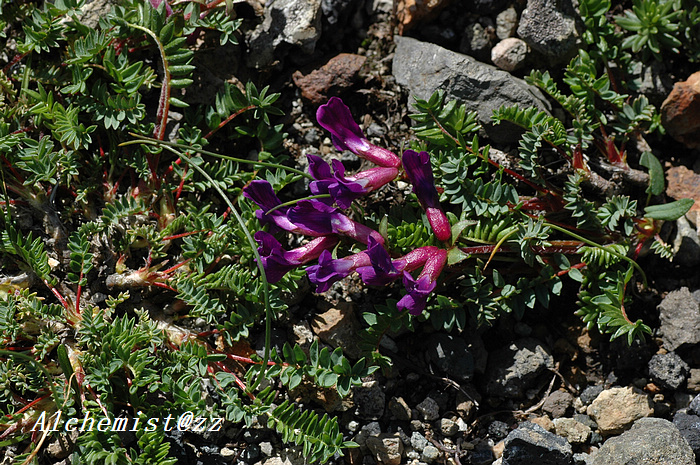长白棘豆 Oxytropis anertii
- Scientific Name: Oxytropis anertii Nakai
- Ref: T.Nakai, Rep. Exped. Manchoukuo Sect. IV 2:125. 1935
- Synonym: Oxytropis anertii var. albiflora Z.J.Zong & X.R.He
- English Common Name: Anert’s locoweed
- Chinese Common Name: 长白棘豆 Chángbái jídòu
- Japanese Common Name: ミヤマオウギ [深山黄耆] miyamaōgi
- Family: Fabaceae
- Genus: Oxytropis
- Distribution: Gravelly alpine grasslands, forest margins, damp places, frozen soils in alpine areas; 1800-3000 m. Jilin [Korea].
- Photo: 07/14/2008, Mt. Changbai, Jilin
Herbs, 6-8(-10) cm tall, acaulescent, from a well-developed multiheaded caudex, tufted. Branches with a thatch of marcescent leaves, with long trichomes when young. Stipules narrowly triangular, 5-13 × 2-5 mm, connate for more than basal half. Leaves 3.5-8 cm or 16-27 cm, 17-35-foliolate; leaflet blades ovate, 5-10 × 1-3 mm, subglabrous. Racemes rather lax, 2-8-flowered; peduncle 3-6 cm, as long as to slightly longer than leaves, with short trichomes; bracts triangular, 2-3 × ca. 2 mm, pubescent. Calyx campanulate, 8-10.5 × 2-3 mm, with whitish trichomes; lobes subulate, 2-3 × 0.5-1 mm. Corolla blue, bluish purple, or light purple; standard 1.5-2 cm, lamina obovate, apex emarginate; wings 1.6-1.8 cm, lamina obovate, apex 2-lobed; keel ca. 1.3 cm, beak ca. 1 mm. Legume sessile, ovoid to oblong, 1.3-2.4 × 0.6-1 cm, inflated, glabrous or pubescent. Fl. Jun-Aug, fr. Aug-Sep. (Flora of China)

07/26/2008, Mt. Changbai, Jilin
